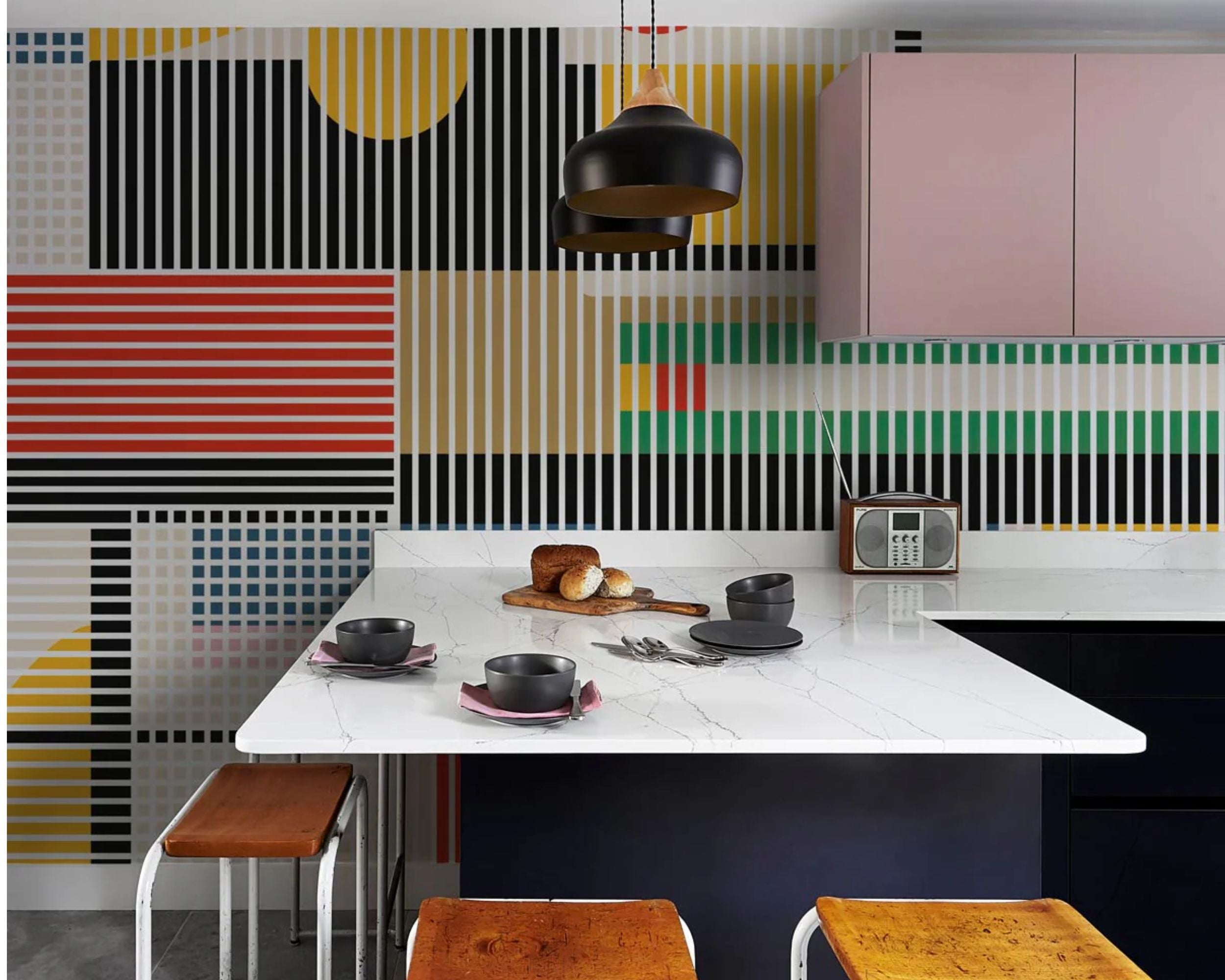Table of Contents
- Introduction to Wallpaper for Walls and Ceilings
- Advantages of Using Wallpaper in Interior Decoration
- Types of Wallpaper: Non-Woven, Vinyl, and Peel and Stick
- How to Prepare the Surface Before Wallpapering
- Steps for Wallpapering Walls and Ceilings with Non-Woven Wallpaper
- Steps for Wallpapering Walls and Ceilings with Vinyl Wallpaper
- Steps for Wallpapering Walls and Ceilings with Peel and Stick Wallpaper
- Tips and Tricks for a Professional Finish
- Inspiration and Trends in Wallpaper Decoration
- Final Conclusions and Recommendations
Do you want to give your walls and ceilings a new look? Look no further! In this article, we’ll show you how to wallpaper easily and achieve professional results using three types of wallpaper: Non-Woven, Vinyl, and Peel and Stick.
Choosing the right type of wallpaper is essential to achieve the desired result. With Non-Woven wallpaper, you’ll enjoy quick and easy installation, as you don’t need to apply paste to the paper; just apply adhesive directly onto the wall. On the other hand, Vinyl wallpaper offers greater durability and resistance to moisture, making it ideal for bathrooms and kitchens. If you’re looking for an even easier option, Peel and Stick wallpaper adheres directly to the surface without the need for additional adhesives.
Read on to discover the key steps in the wallpapering process, decorating tips, and the best brands available. Transform your home with quality wallpaper and add a creative touch to your spaces. Don’t wait any longer—start wallpapering today!
Introduction to Wallpaper for Walls and Ceilings
Wallpaper has re-emerged as one of the most popular trends in interior decoration, offering an effective and aesthetic way to transform spaces. Unlike paint, which can be monotonous and limited in options, wallpaper opens up a world of creative possibilities. From elegant designs to bold patterns, there’s wallpaper for every style and preference, allowing complete customization of your space.
Wallpapering walls and ceilings is not just about aesthetics; it’s also functional. Wallpapers can help improve the acoustics of a room, provide thermal insulation, and, in some cases, even be more durable than paint. Additionally, they are an excellent solution for concealing imperfections on surfaces, turning an ordinary space into something exceptional.
With advances in manufacturing techniques, we now have access to high-quality wallpapers, such as Non-Woven, Vinyl, and Peel and Stick. Each of these types offers unique characteristics that cater to different needs and tastes, making it easy to find the perfect option for any project. In this article, we’ll explore everything needed for successful wallpapering, from surface preparation to the specific steps for each type of wallpaper.
Advantages of Using Wallpaper in Interior Decoration
One of the main advantages of using wallpaper is its ability to instantly transform a space. With a wide variety of colors, patterns, and textures, wallpaper allows homeowners to express their personal style in a way that paint simply cannot match. Whether you’re looking for a minimalist design or a vibrant print, wallpaper offers endless options for every corner of the home.
Additionally, wallpaper can be a more durable option than paint. High-quality wallpapers, especially vinyl, are resistant to moisture and abrasion, making them ideal for high-traffic areas or humid environments such as kitchens and bathrooms. This means you not only get an attractive aesthetic but also invest in a solution that will stand the test of time, maintaining its appearance without the need for constant touch-ups.
Finally, wallpaper can also contribute to sustainability in home decor. Many manufacturers are opting for eco-friendly processes and recycled materials in wallpaper production. This allows consumers to make more conscious and responsible choices, creating a home that is not only beautiful but also respectful of the environment.
Types of Wallpaper: Non-Woven, Vinyl, and Peel and Stick
Non-Woven wallpaper is one of the most popular options today. It is known for its ease of installation and its ability to hide imperfections on walls. This type of wallpaper is made of cellulose and polyester fibers, making it strong and durable. Additionally, it does not require pre-pasting, as adhesive is applied directly onto the wall, speeding up the wallpapering process.
On the other hand, Vinyl wallpaper is designed to offer greater durability and resistance to moisture. This type of wallpaper is ideal for spaces like bathrooms and kitchens, where exposure to moisture can be an issue. Vinyl can be cleaned easily, making it a practical option for homes with children or pets. Its wide range of designs and textures also allows for great creativity in decorating.
Finally, Peel and Stick wallpaper represents the simplest option for those seeking a quick and hassle-free solution. This type of wallpaper adheres directly to the surface without the need for additional adhesives, allowing for a mess-free installation. Additionally, if you decide to change the design, these wallpapers are easy to remove and leave no residue, making them ideal for renters or those who want to experiment with different styles.
WALLPAPER NON WOVEN
WALLPAPER METALLIC
WALLPAPER VINYL
How to Prepare the Surface Before Wallpapering
Before starting to wallpaper, it’s crucial to properly prepare the surface where the paper will be applied. This includes cleaning the wall to remove dust, dirt, or grease that may affect the wallpaper's adhesion. Use a damp cloth and, if necessary, a mild detergent to ensure the surface is completely clean. Allow it to dry thoroughly before proceeding.
Once the wall is clean, check for any imperfections, such as holes or cracks. These must be repaired before wallpapering, as wallpaper will not adequately cover these flaws. Use filler to fill in holes and cracks, then gently sand the surface to make it smooth and even. A smooth finish ensures the wallpaper adheres correctly and gives a professional result.
Finally, if the surface is too absorbent, such as plaster walls or matte paint, it may be helpful to apply a layer of sealant or primer. This will help the adhesive stick better and prevent the paper from deforming by absorbing moisture. With proper preparation, you’ll be ready to enjoy a smoother and more successful wallpapering process.
Steps for Wallpapering Walls and Ceilings with Non-Woven Wallpaper
Wallpapering with Non-Woven wallpaper is a simple process that can be done in a few steps. First, ensure you have all the necessary tools: a roller or brush for applying adhesive, a cutting knife, a square, and a spatula to smooth the paper. Once everything is ready, begin by applying the adhesive to the wall with a roller, making sure to cover the surface well.
Next, cut the strips of wallpaper to the appropriate length, allowing them to extend beyond the top and bottom edges. Start placing the first strip of wallpaper from the corner of the wall, aligning it vertically. Use the spatula to press the paper against the wall and remove any air bubbles. If needed, trim the excess paper at the top and bottom with a knife.
Continue with the next panel, ensuring that the patterns match. As with the first panel, apply adhesive, align, and press. It’s important to check the verticality of the strips with the square for a perfect result. Once the entire area is wallpapered, check for any air bubbles and allow it to dry according to the manufacturer’s instructions.
Steps for Wallpapering Walls and Ceilings with Vinyl Wallpaper
Installing vinyl wallpaper is similar to installing Non-Woven wallpapers, but with some key differences. To begin, ensure the surface is clean and dry. Apply the adhesive to the wall evenly, using a roller or brush. Due to the vinyl material, it’s recommended to use a specific adhesive for this type of wallpaper.
Cut the vinyl wallpaper strips to the appropriate length, ensuring they have a margin for trimming. As with the previous type, start the installation from a corner, carefully aligning the first strip. Once the strip is in place, use the spatula to smooth the paper and remove any air bubbles.
A key feature of vinyl wallpaper is its ease of cleaning. So, make sure the strips are well adhered before proceeding to clean the surface. Once finished, check each strip to ensure they are well positioned and that no gaps are visible between them. Allow it to dry completely before rearranging the space.
Steps for Wallpapering Walls and Ceilings with Peel and Stick Wallpaper
Wallpapering with Peel and Stick wallpaper is one of the simplest and quickest options. Begin by choosing a design you like and ensuring that the surface is clean and dry. Unlike other types of wallpaper, no adhesive is required, as the paper already has an adhesive layer on the back. Simply peel off the backing and start placing the paper on the wall.

Begin in a corner and carefully align the wallpaper. It’s recommended to work from top to bottom to prevent air bubbles from forming. As you apply the paper, use a spatula to smooth and press firmly, ensuring it adheres well to the surface.

If you need to adjust the paper or wish to change it later, Peel and Stick wallpaper can be removed and reapplied without damaging the wall. This is especially useful for renters or for those who like to redecorate often. Once you have finished applying the wallpaper, check the edges to make sure they are firmly attached. Enjoy your new space hassle-free.
Tips and Tricks for a Professional Finish
To achieve a professional finish when wallpapering, there are some tips and tricks that can make a difference. First, be sure to work in good lighting, as this will allow you to see details better and avoid mistakes. It’s also helpful to have a level on hand to ensure the wallpaper strips are correctly aligned and vertical.
Another important tip is to start wallpapering from a corner and follow a specific direction, either left to right or top to bottom. This will help you maintain a uniform pattern and avoid misalignment. Additionally, don’t rush the process; take your time to smooth out air bubbles and adjust the wallpaper as needed.
Finally, consider applying a sealant to the edges of the wallpaper, especially in areas prone to moisture. This will help ensure the wallpaper stays in place and won’t peel over time. With these tips, you’ll enjoy a final result that is not only attractive but also durable.
Inspiration and Trends in Wallpaper Decoration
The use of wallpaper in interior decoration has evolved, and today there is a wide variety of trends to follow. One of the most popular is using wallpapers with geometric patterns that bring a modern and elegant touch to any room. These designs can be used as accents on one wall or on ceilings to create a striking effect.
Another trend on the rise is using wallpapers with natural motifs, such as flowers, leaves, and landscapes. These designs can bring a fresh and relaxing vibe to indoor spaces, especially in living rooms or bedrooms. Textured wallpapers are also trending, adding depth and warmth to the walls.
Finally, don’t forget the option of mixing and matching different types of wallpaper. This technique is ideal for creating a unique and personalized space. You could choose an accent wallpaper for one wall and a more subtle design on adjacent walls. The key is to balance colors and patterns so they flow harmoniously in the space.
Final Conclusions and Recommendations
Wallpapering walls and ceilings is an excellent way to revitalize any space in your home, and with the options of Non-Woven, Vinyl, and Peel and Stick wallpapers, there’s a solution for every need. The choice of wallpaper type will depend on your aesthetic preferences as well as the functionality you seek. Remember that proper surface preparation is essential to ensure a durable and satisfactory result.
Don’t hesitate to experiment with different designs and patterns, and remember that decoration is a form of personal expression. Take advantage of the variety of options available on the market to find the style that best suits you. Additionally, follow the tips and tricks we’ve shared to achieve a professional finish that makes your spaces feel refreshed and welcoming.
Finally, whatever design you choose, enjoy the process of transforming your home. Wallpapering is not just a task; it’s an opportunity to create an environment that reflects your personality and style. So, let’s get started and begin your wallpapering project today!








